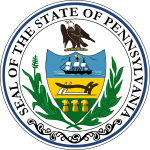| |||||||||||||||||||
All 18 Pennsylvania seats to the United States House of Representatives | |||||||||||||||||||
|---|---|---|---|---|---|---|---|---|---|---|---|---|---|---|---|---|---|---|---|
| |||||||||||||||||||
Elections to the United States House of Representatives were held in Pennsylvania on October 11, 1808, for the 11th Congress.
Background
Eighteen Representatives had been elected in the previous election, 15 Democratic-Republicans and 3 Federalists. All three Federalists and two of the Democratic-Republicans were quids, an alliance of moderate Democratic-Republicans and Federalists. One seat held by a Democratic-Republican had become vacant prior to this election and was filled in a special election held at the same time as this election.
Congressional districts
Pennsylvania was divided into 11 districts, of which four were plural districts with 11 Representatives between them, with the remaining 7 Representatives elected from single-member districts. The districts were:
- The 1st district (3 seats) consisted of Delaware and Philadelphia counties (including the City of Philadelphia)
- The 2nd district (3 seats) consisted of Bucks, Luzerne, Montgomery, Northampton, and Wayne Counties
- The 3rd district (3 seats) consisted of Berks, Chester, and Lancaster Counties
- The 4th district (2 seats) consisted of Cumberland, Dauphin, Huntingdon, and Mifflin Counties
- The 5th district consisted of Centre, Clearfield, Lycoming, McKean, Northumberland, Potter, and Tioga Counties
- The 6th district consisted of Adams and York Counties
- The 7th district consisted of Bedford and Franklin Counties
- The 8th district consisted of Armstrong, Cambria, Indiana, Jefferson, Somerset, and Westmoreland Counties
- The 9th district consisted of Fayette and Greene Counties
- The 10th district consisted of Washington County
- The 11th district consisted of Allegheny, Beaver, Butler, Crawford, Erie, Mercer, Venango, and Warren Counties
Luzerne County's western border was altered between the 1806 and 1808 elections, altering the boundary between the 2nd and 5th districts
Note: Many of these counties covered much larger areas than they do today, having since been divided into smaller counties
Election results
Thirteen incumbents (10 Democratic-Republicans and 3 Federalists) ran for re-election, of whom 11 won re-election. The incumbents Jacob Richards (DR) of the 1st district, John Hiester (DR) of the 3rd district, Daniel Montgomery (DR) of the 5th district and William Hoge (DR) of the 10th district did not run for re-election. There was also a vacancy in the 1st district. One seat changed from Federalist to Democratic-Republican control.
| District | Democratic-Republican | Quid | Federalist | ||||||
|---|---|---|---|---|---|---|---|---|---|
| 1st 3 seats |
Benjamin Say | 7,598 | 18.5% | Joseph Hemphill | 6,123 | 14.9% | |||
| John Porter (I) | 7,589 | 18.5% | Derick Peterson | 6,098 | 14.9% | ||||
| William Anderson | 7,559 | 18.4% | Charles W. Hare | 6,052 | 14.8% | ||||
| 2nd 3 seats |
Robert Brown (I) | 9,218 | 16.9% | John Ross | 9,167 | 16.8% | |||
| John Pugh (I) | 9,090 | 16.7% | William Milnor (I) | 9,095 | 16.7% | ||||
| John Hahn | 9,026 | 16.6% | Roswell Wells | 8,941 | 16.4% | ||||
| 3rd 3 seats |
John Whitehill | 10,216 | 16.4% | Matthias Richards (I) | 10,652 | 17.1% | |||
| Roger Davis | 10,161 | 16.3% | Daniel Hiester | 10,652 | 17.1% | ||||
| William Witman | 10,121 | 16.2% | Robert Jenkins (I) | 10,542 | 16.9% | ||||
| 4th 2 seats |
Robert Whitehill (I) | 8,807 | 36.7% | John Gloninger | 3,228 | 13.5% | |||
| David Bard (I) | 8,774 | 36.6% | William Alexander | 3,165 | 13.2% | ||||
| 5th | George Smith | 7,191 | 82.3% | John Bull | 1,549 | 17.7% | |||
| 6th | William Crawford | 3,506 | 52.4% | James Kelly (I) | 3,188 | 47.6% | |||
| 7th | John Rea (I) | 3,496 | 61.5% | Andrew Dunlap | 2,191 | 38.5% | |||
| 8th | John Kirkpatrick | 1,732 | 29.1% | William Findley (I) | 2,718 | 45.7% | |||
| Robert Philson | 1,502 | 25.2% | |||||||
| 9th | John Smilie (I) | 3,183 | 67.3% | Thomas Meason | 1,550 | 32.7% | |||
| 10th | Aaron Lyle (I) | 3,425 | 76.5% | John Hamilton | 1,053 | 23.5% | |||
| 11th | Samuel Smith (I) | 6,206 | 68.3% | Alexander Foster | 2,885 | 31.7% | |||
| 1st (special) | Benjamin Say | 7,598 | 55.7% | Charles W. Hare | 6,046 | 44.3% | |||
Special election
Benjamin Say (DR) of the 1st district resigned in June, 1809, and a special election was held to fill the resulting vacancy
| District | Democratic-Republican | ||
|---|---|---|---|
| 1st | Adam Seybert | 5,936 | 59.5% |
| Richard R. Smith | 4,043 | 40.5% | |
References
- Electoral data and information on districts are from the Wilkes University Elections Statistics Project
| (1807←) 1808 United States elections (→1809) | |
|---|---|
| U.S. President | |
| U.S. Senate | |
| U.S. House | |
| Governors | |
| States and territories | |
| United States House of Representatives elections | |||||
|---|---|---|---|---|---|
| Elections spanning two years (through 1879) |
| ||||
| Elections held in a single year (starting 1880) |
| ||||
| Elections by state |
| ||||
| Seat ratings | |||||
| Speaker elections | |||||
| Summaries | |||||
- Won special election to 10th Congress
- ^ Aligned with the Democratic-Republicans
- ^ Aligned with the Federalists
- Ran as "American Republican"
